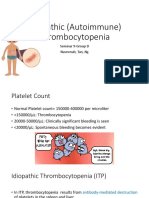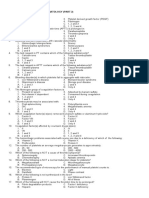0 ratings0% found this document useful (0 votes)
15 viewsBCQS
BCQS
Uploaded by
Asma ShoaibThrombopoietin levels are very high in immune thrombocytopenic purpura and liver failure due to increased production to compensate for low platelet counts. Aplastic anemia results from impaired bone marrow function that decreases platelet production. Chronic idiopathic thrombocytopenic purpura is commonly marked by easy bruising, epistaxis, and petechiae but subarachnoid hemorrhage is an uncommon finding.
Copyright:
© All Rights Reserved
Available Formats
Download as PPTX, PDF, TXT or read online from Scribd
BCQS
BCQS
Uploaded by
Asma Shoaib0 ratings0% found this document useful (0 votes)
15 views3 pagesThrombopoietin levels are very high in immune thrombocytopenic purpura and liver failure due to increased production to compensate for low platelet counts. Aplastic anemia results from impaired bone marrow function that decreases platelet production. Chronic idiopathic thrombocytopenic purpura is commonly marked by easy bruising, epistaxis, and petechiae but subarachnoid hemorrhage is an uncommon finding.
Original Description:
bio
Copyright
© © All Rights Reserved
Available Formats
PPTX, PDF, TXT or read online from Scribd
Share this document
Did you find this document useful?
Is this content inappropriate?
Thrombopoietin levels are very high in immune thrombocytopenic purpura and liver failure due to increased production to compensate for low platelet counts. Aplastic anemia results from impaired bone marrow function that decreases platelet production. Chronic idiopathic thrombocytopenic purpura is commonly marked by easy bruising, epistaxis, and petechiae but subarachnoid hemorrhage is an uncommon finding.
Copyright:
© All Rights Reserved
Available Formats
Download as PPTX, PDF, TXT or read online from Scribd
Download as pptx, pdf, or txt
0 ratings0% found this document useful (0 votes)
15 views3 pagesBCQS
BCQS
Uploaded by
Asma ShoaibThrombopoietin levels are very high in immune thrombocytopenic purpura and liver failure due to increased production to compensate for low platelet counts. Aplastic anemia results from impaired bone marrow function that decreases platelet production. Chronic idiopathic thrombocytopenic purpura is commonly marked by easy bruising, epistaxis, and petechiae but subarachnoid hemorrhage is an uncommon finding.
Copyright:
© All Rights Reserved
Available Formats
Download as PPTX, PDF, TXT or read online from Scribd
Download as pptx, pdf, or txt
You are on page 1of 3
BCQS
1. Thrombopoietin (Tpo) is the primary regulator of
megakaryocyte growth and development. Very high levels of Tpo
are seen which two of the following conditions?
A.Immune thrombocytopenic purpura (ITP)
B.Liver failure
C.Aplastic anemia
D.Congenital amegakaryocytic thrombocytopenia (CAMT)
2.Thrombotic thrombocytopenia is characterized by:
A.Low platelet count
B. Increased reticulocyte count
C.Decreased platelet count
D.A and B both
3. Aplastic anemia results in:
A.Selective impairment of bonemarrow dysfunction
B. Decreased platelet survival
C. Increased megakaryopoeisis
D. Decreased production of platelets
4. The uncommon finding of chronic idiopathic
thrombocytopenic purpura is:
A. Easy bruising
B.Epistaxis
C. Subarachnoid hemorrhage
D. Petechiae
You might also like
- Hematology McqsDocument5 pagesHematology McqsMuhammad Arslan Gill81% (16)
- Hematology Mcqs PDFDocument5 pagesHematology Mcqs PDFJennelle Cadogan100% (5)
- Hemodynamic DisordersDocument6 pagesHemodynamic DisordersPradeep100% (1)
- CH 7 Blood Disorders F FF FDocument75 pagesCH 7 Blood Disorders F FF FZainab AbbasNo ratings yet
- Patho - Platelets AtfDocument19 pagesPatho - Platelets AtfGaurav ThapaNo ratings yet
- Module 4 ThrombocytopeniaDocument2 pagesModule 4 Thrombocytopeniaemmanuelakinola2006No ratings yet
- PBL ViiDocument28 pagesPBL ViiNUR AFRINo ratings yet
- 10. trombositopenia PSPDGDocument13 pages10. trombositopenia PSPDGadindafresh99No ratings yet
- 345 - Hematology Physiology) PolycythemiasDocument3 pages345 - Hematology Physiology) PolycythemiasAro DanaNo ratings yet
- Thrombotic Thrombocytopenic Purpura, Heparin-Induced Thrombocytopenia, and Disseminated Intravascular Coagulation 2020Document21 pagesThrombotic Thrombocytopenic Purpura, Heparin-Induced Thrombocytopenia, and Disseminated Intravascular Coagulation 2020Cris TobalNo ratings yet
- coagulation thrompocytopeniaDocument29 pagescoagulation thrompocytopeniaGiD MOhNo ratings yet
- 1 Hematology Mcqs PDFDocument5 pages1 Hematology Mcqs PDFSatouri Haythem100% (1)
- (2025) Pathology FQ1Document4 pages(2025) Pathology FQ1sytrix828No ratings yet
- Platelet Count Direct Method Activity (MANALO)Document3 pagesPlatelet Count Direct Method Activity (MANALO)Rose ValerieNo ratings yet
- Causes of Thromboctyopenia &Document30 pagesCauses of Thromboctyopenia &Rishabh SinghNo ratings yet
- Idiopathic Thrombocytopenic PurpuraDocument5 pagesIdiopathic Thrombocytopenic Purpurasaputra tri nopiantoNo ratings yet
- HaematologyDocument28 pagesHaematologyfh fgNo ratings yet
- Bleeding DisordersDocument35 pagesBleeding Disorderskholoud220100% (5)
- Pathology CAT 05 MCQs With AnswersDocument9 pagesPathology CAT 05 MCQs With Answers0109imzaadhnadhryNo ratings yet
- Quantitative Platelet DisorderDocument75 pagesQuantitative Platelet Disorderirishgopez24No ratings yet
- Thrombocytopenia Thrombotic Thrombocytopenic Purpura: DR Ahmad Abu Al-Samen MDDocument17 pagesThrombocytopenia Thrombotic Thrombocytopenic Purpura: DR Ahmad Abu Al-Samen MDmohNo ratings yet
- Seminar 9-ITPDocument22 pagesSeminar 9-ITPanon_67984147No ratings yet
- HUS & TTP (Ref. Hari. 18 Ed., Pg-970)Document4 pagesHUS & TTP (Ref. Hari. 18 Ed., Pg-970)Sudip DevadasNo ratings yet
- 15 - Platelet DisordersDocument10 pages15 - Platelet Disordersbascoadrienne0No ratings yet
- 3rd CBC & Blood IndicesDocument65 pages3rd CBC & Blood Indicesso mohamedNo ratings yet
- MCQ HematologyDocument12 pagesMCQ Hematologymohamed mowafeyNo ratings yet
- Lecture 16 - Bleeding Tendency DiseasesDocument64 pagesLecture 16 - Bleeding Tendency Diseasesapi-3703352100% (1)
- Trombositopenia: Linda Rotty BGN/SMF Ilmu Penyakit Dalam FK Unsrat 2012Document26 pagesTrombositopenia: Linda Rotty BGN/SMF Ilmu Penyakit Dalam FK Unsrat 2012Gideon Abdi TombokanNo ratings yet
- Bleeding Disorders of Primary HemostasisDocument18 pagesBleeding Disorders of Primary Hemostasisمصطفي خندقاويNo ratings yet
- ET (New), UMI Juli 2013Document15 pagesET (New), UMI Juli 2013L M AkhiruddinNo ratings yet
- CCRN PCCN Review Hematology ImmunologyDocument7 pagesCCRN PCCN Review Hematology ImmunologyGiovanni MictilNo ratings yet
- Disorder of PlateletsDocument27 pagesDisorder of PlateletsRoby KieranNo ratings yet
- THROMBOSISDocument11 pagesTHROMBOSISChandan DebbarmaNo ratings yet
- Platelets DashDocument28 pagesPlatelets Dashjadaboswell11No ratings yet
- Disorders of PlateletsfDocument51 pagesDisorders of PlateletsfSyarifah Tridani FitriaNo ratings yet
- Aneamis and HaematologyDocument129 pagesAneamis and HaematologyiwennieNo ratings yet
- Ticket 1Document12 pagesTicket 1malihah qaziNo ratings yet
- DR Kieu MyDocument26 pagesDR Kieu MyMa VuongNo ratings yet
- Blood Indices 2Document10 pagesBlood Indices 2sygqj4xr7cNo ratings yet
- Unit 4 Study Guide PathoDocument10 pagesUnit 4 Study Guide Pathoangieswenson100% (1)
- Pre-Board Examination in Hematology (Part 2)Document6 pagesPre-Board Examination in Hematology (Part 2)Godofredo HermosuraNo ratings yet
- Pathology Bleeding DisordersDocument67 pagesPathology Bleeding DisordersMarcelliaNo ratings yet
- General Medicine MCQDocument73 pagesGeneral Medicine MCQkhalida shaik begumNo ratings yet
- (2005) AAP Thrombocytopenia in ChildhoddDocument11 pages(2005) AAP Thrombocytopenia in ChildhoddFabiola Vania FeliciaNo ratings yet
- MCQ Haemato (DivC)Document6 pagesMCQ Haemato (DivC)Muhammad Nazif0% (2)
- Chapter 15+17 Hemorrhagic Disease & Thrombocytopenic PurpuraDocument20 pagesChapter 15+17 Hemorrhagic Disease & Thrombocytopenic PurpuraFathimathNo ratings yet
- Trombocytopenia Uniba 16-1-13Document32 pagesTrombocytopenia Uniba 16-1-13Dwiki Surya PrayogaNo ratings yet
- Pathology: Fluid & Hemodynamic Derangement - MCQDocument5 pagesPathology: Fluid & Hemodynamic Derangement - MCQahmed jaradNo ratings yet
- Untitled DocumentDocument9 pagesUntitled DocumentКлинические дисциплины 3No ratings yet
- Bleeding Disorders: (Hemorragic Diathesis)Document25 pagesBleeding Disorders: (Hemorragic Diathesis)nurina_abdrahimNo ratings yet
- Hematology Mid Semester ExamDocument9 pagesHematology Mid Semester Examsahar100% (1)
- HEMOGRAMDocument28 pagesHEMOGRAMDoc HamsNo ratings yet
- 1 Hema QuestionnaireDocument20 pages1 Hema QuestionnaireVince Lester LataNo ratings yet
- 1.1 Ae 1 HemaDocument28 pages1.1 Ae 1 HemaRonelene GatoNo ratings yet
- Each of The Following Samples May Be Used in Hematology ExceptDocument5 pagesEach of The Following Samples May Be Used in Hematology ExceptEarleen Del Rosario100% (1)
- (Stasi) How To Approach Thrombocytopenia PDFDocument7 pages(Stasi) How To Approach Thrombocytopenia PDFrodtobingNo ratings yet
- Fast Facts: Leukemia: From initial gene mutation to survivorship supportFrom EverandFast Facts: Leukemia: From initial gene mutation to survivorship supportNo ratings yet
- Cpec Impact On Economy and Industry: Presenter: Muhammad SaadDocument19 pagesCpec Impact On Economy and Industry: Presenter: Muhammad SaadAsma ShoaibNo ratings yet
- Project Scope Management: Scope Planning Scope Definition Creating WBS Scope Verification Scope ControlDocument31 pagesProject Scope Management: Scope Planning Scope Definition Creating WBS Scope Verification Scope ControlAsma ShoaibNo ratings yet
- Asma RiskDocument2 pagesAsma RiskAsma ShoaibNo ratings yet
- Managing Project-2nd SessionDocument15 pagesManaging Project-2nd SessionAsma ShoaibNo ratings yet
- Critical Review On Poor LeadershipDocument7 pagesCritical Review On Poor LeadershipAsma ShoaibNo ratings yet
- Gender ReviewDocument5 pagesGender ReviewAsma ShoaibNo ratings yet
- Leadership Review 1Document20 pagesLeadership Review 1Asma ShoaibNo ratings yet
- Prudential Regulations For Corporate / Commercial BankingDocument73 pagesPrudential Regulations For Corporate / Commercial BankingAsma ShoaibNo ratings yet
- SM Group Assignment - Backward Integration Final & ModifiedDocument30 pagesSM Group Assignment - Backward Integration Final & ModifiedAsma ShoaibNo ratings yet
- HRMDocument25 pagesHRMAsma Shoaib100% (1)
- Situational PowerPointDocument20 pagesSituational PowerPointAsma ShoaibNo ratings yet
- From NetDocument51 pagesFrom NetAsma ShoaibNo ratings yet
- Financial Assets and Financial LiabilitiesDocument4 pagesFinancial Assets and Financial LiabilitiesAsma ShoaibNo ratings yet
- 16TH FebDocument11 pages16TH FebAsma ShoaibNo ratings yet
- Pakistan International AirlinesDocument5 pagesPakistan International AirlinesAsma ShoaibNo ratings yet
- 21ST FebDocument12 pages21ST FebAsma ShoaibNo ratings yet
- Analysis of e Business Models For Digital Media ContentDocument3 pagesAnalysis of e Business Models For Digital Media ContentAsma ShoaibNo ratings yet
- Planning & Managing Inventory in Supply Chain: Cycle Inventory, Safety Inventory, ABC Inventory & Product AvailabilityDocument24 pagesPlanning & Managing Inventory in Supply Chain: Cycle Inventory, Safety Inventory, ABC Inventory & Product AvailabilityAsma ShoaibNo ratings yet













































































